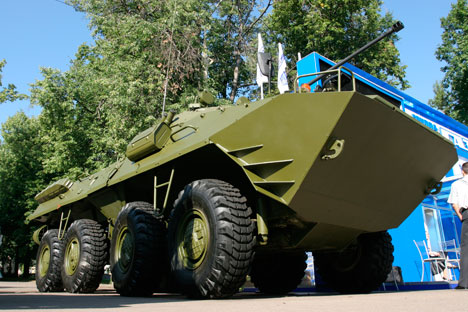Hybrid personnel carriers manufactured in Russia

New hybrid BTR “Krymsk” can move silently on molecular drives when the engines are turned off. Source: ITAR-TASS
The new millennium has already been marked by dozens of localized conflicts, counter-terrorist operations and peacekeeping missions. It is clear that missile carriers and battle tanks are no longer enough to protect and serve the many military bases scattered around the world that any self-respecting state should have — especially a superpower.
Lightweight, high-speed wheeled and tracked, and even amphibious, armored vehicles are needed to deploy special forces quickly, deliver everything necessary to war zones, and adequately protect military targets. The most promising of these are wheeled vehicles, due to their simplicity and low operating costs, as well as their high degree of maneuverability and superior speed.
In terms of tank construction, the Soviet Union — and now Russia — had no equals. The same cannot be said of armored vehicles, however, the development and production of which has always languished far behind. Until now.
In late July, Russia’s Voenno-Promyshlennaya Kompania (Military-Industrial Company, or VPK for short) announced that it had been developing and was in the early stages of testing a wheeled chassis for future armored vehicles. The new project, called “Krymsk,” aims to eliminate the main drawback of current armored vehicles — namely, the poor propulsion technology.
In the words of project director Viktor Rudin, “The prototype vehicle is equipped with a hybrid engine and electric transmission, which could provide significant advantages in the field.”
What is innovative about the new vehicle is that the internal combustion engine drives the generator rotor, generating an alternating current, which is then converted into a direct current.
Next, energy is supplied to the traction motors through a system of transformers, resulting in the wheel’s rotation. At the same time, electrical energy is supplied to the molecular drive. When breaking, kinetic energy is converted into electrical energy that is also supplied to the drive.
Armored vehicles of this kind can move silently on molecular drives when the engines are turned off. At the moment, the power reserve is nothing significant; however, if advanced lithium-ion phosphate batteries are used (they are already produced in Russia), then operating times may be increased by many dozen times. Silent operation is an extremely important advantage of such armored vehicles during covert operations.
The armored vehicle’s dynamic properties are no less impressive. During tests in the Greater Moscow area, the 22-ton machine reached speeds of up to 97 kilometers per hour (roughly 60 miles per hour), and went from 0–80 kilometers per hour (0–50 miles per hour) in just 33 seconds.
There is one more important factor. The international community of military experts is certain that the future of armored vehicles lies in the creation of automated systems. “Krymsk is almost completely remotely controlled,” says Rudin.
“The electronic systems of the prototype model already allow for remote operation; with some minor revisions and the development of the necessary control algorithms and programs, a fully functioning robotic platform could be a reality.”
Unfortunately, Russian wheeled armored vehicles are far from the standards mentioned above. There are only two machines in the armored personnel and infantry fighting vehicles’ class— namely, the BTR-70 and BTR-80.
However, these are nothing more than ungraded versions of the BTR-60 series vehicles, which were developed back in the late 1950s. The main improvements of the BTR-70 and BTR-80 models are that they replaced the old petrol engines with newer and more powerful petrol engines — 120 horsepower for the BTR-70 and 210 horsepower for the BTR-80.
Related:
Tula arms producer creates amphibious assault rifle
In 1994, GAZ unveiled the new BTR-90 to the public. Serial production was supposed to start in 2011, but the Ministry of Defense sensationally abandoned these plans.
Col. Gen. Sergei Mayev, who was director of the Federal Service for Defense Contracts at the time, had the following to say about the vehicle: “The vehicle has a checkered past. The prototype model was completed at the end of the 20th century, at a time when the military-industrial complex was falling apart […] and serial purchases of armored vehicles had come to a halt […] State tests performed in 1996 showed that the vehicle did not fulfil all the tactical and technical requirements.”
Evidently, the developers failed to meet the requirements of the military. Production of the BTR-80 has also been discontinued. It has also endured a less than stellar existence.
If the course of Russian strategic weapons — the role of which has not changed — is more or less clear, then the future of lightweight armored vehicles now lies with the development of machines like the Krymsk.
All rights reserved by Rossiyskaya Gazeta.
Subscribe
to our newsletter!
Get the week's best stories straight to your inbox

